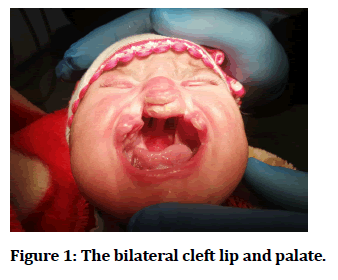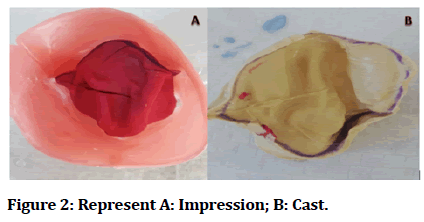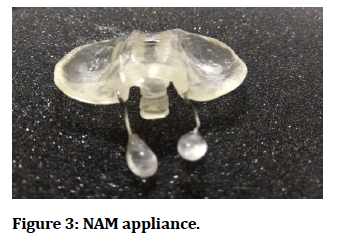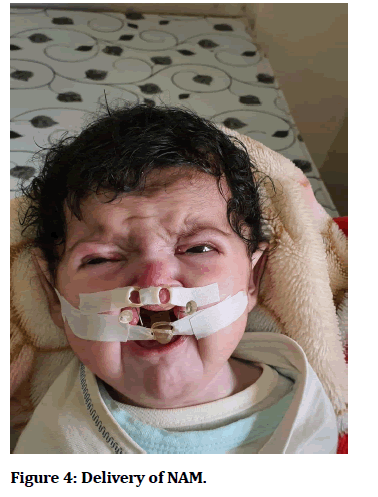Research - (2022) Volume 10, Issue 1
Naso-Alveolar Mold (NAM) Appliance in Treating Seven Cleft Lip and Palate Neonates
Saja Kareem Esmael1*, Mudher MB Alsunbuli1 and Mithaq Adnan Zebun2
*Correspondence: Saja Kareem Esmael, Al-Bayan University, College of Dentistry, Baghdad, Iraq, Email:
Abstract
The major goal of the present is to explore the significance of using a nasoalveolar molding device as pre-surgical protocol to enhance nasal symmetry and lessen the severity of early cleft deformity in the patients who have Cleft Lip and Palate (CLP).
Keywords
Nasoalveolar, Nasoalveolar molding, Cleft lip, Bilateral cleft, Neonate, Newborn
Introduction
Incomplete formation of the tissue of the lip, alveolus, also soft and hard palate is referred to as CLP. The defect can be as little as a notch in the lip or as large as full cleft that extends into the nose and mouth roof [1]. The goal to lessen the surgical problems of CLP is not new; descriptions of retractions of the protrusive and ectopic premaxilla in the patients with BCLP were recorded as far back as the 16-th century [2]. Beginning with McNeil in 1950, many pre-surgical infant orthopaedic treatments were devised for treating CLP, including Latham and Hotzetal. Georgiade, Nakajima et al and Matsuo et al., [3]. In addition, the NAM appliance is one of the new presurgical orthopaedic devices which enables for positive alveolar ridge growth and re-shaping of the flattened nose into more symmetrical appearance. Due to pre-surgical appliance, the lip and nose might heal with minimum amount of strain, resulting in better esthetic results and less scarring. As a result, the risks of surgical morbidity and expenses of secondary scar surgeries are reduced [4]. In this work, we looked at the advantages of NAM appliance method and presented a case that had been treated with it.
Nasoalveolar molding
In the care of CLP patients, Nasoalveolar molding offers a paradigm shift from standard pre-surgical orthopaedics, which was used more frequently in the past twenty years. This work offers a summary regarding the latest literature on the method's goals, problems, appliances, along with long- and short-term outcomes [5].
Objectives
Reduce the width related to alveolar cleft segments till the gingival tissues are in passive contact. The lip base and nose segments align better as alveolar gap width is reduced [6].
Deformed nasal cartilage and alveolar process are actively moulded and repositioned. Lip segments are moved into a more anatomically accurate position, avoiding lip scarring and adhesion [7].
Decreasing the number of surgical treatments and, as a result, lowering expenditures and the necessity for secondary alveolar bone grafts [8]. By minimizing the cleft size (since the healing of the bone is inversely proportionate to cleft's size), more favourable bone formation can be achieved; which can be approved radiologically, serving infants in generating suckling force by acting as an obturation [9].
Patient, Materials and Methods
Treated cases
Seven neonates (2–30) Days old new born babies came to clinic with the bilateral cleft lip and palate. Only medically fit neonates included in this study (Figure 1).
Figure 1: The bilateral cleft lip and palate.
Technique
Taking impression was carried out to infant with heavy body silicone or impression compound. The neonate held in inverted manner, then the impression was poured with dye stone to construct cast (Figure 2A and 2B).
Figure 2: Represent A: Impression; B: Cast.
The appliance was made of acrylic and included intraoral plate of molding with the nasal stents to simultaneously mold alveolar ridges and nasal cartilage. This stent has been put into nostrils that were affected, at night while the infant sleeps [10], (Figure 3).
Figure 3:NAM appliance.
On molding plate’s palatal surface, a small opening of diameter between (6 and 8) mm is constructed. After the alveolus's cleft has been decreased to roughly 5-6mm in width, nasal stent is produced [11]. In addition, the stent is 0.36inch long and is formed of round wire that has been made of stainless-steel in a "swan neck" shape. It's attached to molding plate's labial flange, towards retention arm's bottom. Hard acrylic component has been shaped to a bilobed kidney-like shape. Soft denture liner has been placed on top of the hard acrylic.
Furthermore, top lobe enters nose and gently pushes a dome forward till a small amount of the tissue blanching has been seen. The molding therapy length is determined by severity of the deformity of the initial cleft [12].
Surgical tapes with Orthodontic elastic band at one of the ends are used for securing the appliance extra orally cheeks and bilaterally. Also, the elastics are looped around an arm of retention that extends from a plate's anterior flange.
The arm of the retention is positioned about 40o down from the horizontal. The weekly visits were adopted for the alteration of molding plate, and tapes are replaced once daily, (Figure 4).
Figure 4:Delivery of NAM.
Results and Discussion
All the seven neonates’ patients treated in this study 100% had obvious improvement in direction of the growth and the cleft size with different values, further more clear reduction in disfigurement caused by cleft deficit. The alveolar gap is closed, bringing segments of the lip together, resulting in the reduction of the width of the nasal base, as well as introducing alar rim laxity [6].
NAM benefits
The benefits of NAM could be including the psychosocial advantages for the family of the infant baby [4]. We're presently taking part in multi-center study that has been funded by National Institute of Health in order to assess caregivers' reactions to the NAM. According to preliminary studies, regular visits for NAM modifications lessen caregiver worry and provide a sense of empowerment. In addition, those adjustments occur as the caregiver gains experience with NAM appliances, notices improvements in a baby's look, and gains the counselling and support from a cleft team on weekly basis [13]. According to a recent poll by the American Cleft Palate and Craniofacial Association, surgeons expect improved nasolabial results for the new-borns that have minor clefts instead of severe clefts [14]. Surgeons have classified NAM patients as having modest deformities as well as non-NAM treated the patients as having more serious deformity cases while being blinded to the treatment group [15].
Precautions
Taking impression to infant with heavy body silicone or impression compound have risk of inhalation the neonates must be held in inverted manner for preventing tongue from rolling posteriorly [16].
The nasal stents should be present to simultaneously mold alveolar ridges and nasal cartilage. This stent has been put into nostrils that were affected [14], at night while the infant sleeps to exert traumatic pressure on nasal tissue, reshaping, expanding, and repositioning external nasal structure. Furthermore, intra-oral plates are capable of correcting and repositioning palatal segments [10].
A small opening of diameter (6 and 8) mm on molding plate’s palatal surface, necessarily constructed for allowing an airway if the plate falls posteriorly. For added comfort and decreasing the pressure complications squalene, a soft denture liner has been placed on top of the hard acrylic [12].
For achieving correct activation as well as preventing unseating appliance from a palate, the arm of the retention is positioned about 45o down from the horizontal [6]. The weekly visits adopted of for the alteration of molding plate of great importance for guiding alveolar cleft segments into a proper state.
Complications
Oral mucosa irritations (oral sides of the premaxilla, vestibule, and cheeks), nasal mucosa, and gingival tissues is the most prevalent problem with the NAM appliance. Those issues are most often resulting from the appliance exerting too much force [10]. Intraoral tissues might ulcerate from rubbing or pressure. As the molding plate is retracted, the anterior premaxilla, fraenum attachments, and posterior fauces are common regions of breakdown. At each visit, the infant must be examined, and the molding plate must be correctly relieved in any locations where there is an excessive amount of pressure [17].
Conclusion
NAM therapy has been considered beneficial not just for inducing the growth of the dental alveolar, yet also as pre-surgical orthodontic treatments for improving nasal form as well as treatment outcomes following main lip surgery. Even though long-term stability regarding such results must be evaluated, it may be indicated that using NAM is beneficial throughout postnatal period, in the case where nasal cartilages exhibit a high level of the plasticity, and that the mentioned method can offer correct nasal shapes in the patients who have the CLP.
References
- Kinouchi N, Horiuchi S, Yasue A, et al. Effectiveness of presurgical nasoalveolar molding therapy on unilateral cleft lip nasal deformity. Saudi Med J 2018; 39:169.
- Fedeles J, Ziak P, Fedeles J. Nasoalveolar molding in complete cleft lip nasal deformity patients. Bratislavske Lekarske Listy 2012; 113:293-7.
- Grayson BH, Garfinkle JS. Early cleft management: The case for nasoalveolar molding. Am J Orthod Dentofac Orthop 2014; 145:134.
- Bakker A, Maertens KJ, Van Son MJ, et al. Psychological consequences of pediatric burns from a child and family perspective: A review of the empirical literature. Clinic Psychol Rev 2013; 33:361-71.
- Moetamedi AK, Feizbakhsh M, Mortazavi M, et al. Nasoalveolar molding in cleft lip and palate, a review of literature. J Craniomaxillofac Res 2014; 32-6.
- Grayson BH, Maull D. Nasoalveolar molding for infants born with clefts of the lip, alveolus and palate. Cleft Lip Palate 2006; 451-8.
- Murthy PS, Deshmukh S, Bhagyalakshmi A, et al. Pre surgical nasoalveolar molding: Changing paradigms in early cleft lip and palate rehabilitation. J Int Oral Health 2013; 5:70.
- Krishnan V, Davidovitch ZE, editors. Integrated clinical orthodontics. John Wiley and Sons 2012.
- Kapadia H, Olson D, Tse R, et al. Nasoalveolar molding for unilateral and bilateral cleft lip repair. Oral Maxillofa Surg Clin 2020; 32:197-204.
- Barillas I, Dec W, Warren SM, et al. Nasoalveolar molding improves long-term nasal symmetry in complete unilateral cleft lipâ??cleft palate patients. Plastic Reconstructive Surg 2009; 123:1002-6.
- Koya S, Shetty S, Husain A, et al. Presurgical nasoalveolar molding therapy using Figueroa's NAM technique in unilateral cleft lip and palate patients: a preliminary study. J Clinic Pediatric Dent 2016; 40:410-6.
- Shetye PR, Grayson BH. NasoAlveolar molding treatment protocol in patients with cleft lip and palate. In Seminars in Orthodontics 2017; 23:261-267.
- van der Heijden P, Dijkstra PU, Stellingsma C, et al. Limited evidence for the effect of presurgical nasoalveolar molding in unilateral cleft on nasal symmetry: a call for unified research. Plastic Reconstructive Surg 2013; 131:62-71.
- de Blacam C, Theopold C, Dalli J, et al. Feasibility of cleft lip and palate repair in personal protective equipment (PPE). J Plastic Reconst Aesthetic Surg 2021.
- Abbott MM, Meara JG. Nasoalveolar molding in cleft care: is it efficacious?. Plastic Reconst Surg 2012; 130:659-66.
- Kumar A, Mogre S. Presurgical nasoalveolar molding in a neonate with unilateral cleft lip and palate. J Oral Health Community Dent 2018; 12.
- Yu Q, Gong X, Shen G. CAD presurgical nasoalveolar molding effects on the maxillary morphology in infants with UCLP. Oral Surg Oral Med Oral Pathol Oral Radiol 2013; 116:418-26.
Indexed at, Google Scholar, Cross Ref
Indexed at, Google Scholar, Cross ref
Indexed at, Google Scholar, Cross Ref
Indexed at, Google Scholar, Cross Ref
Indexed at, Google Scholar, Cross Ref
Indexed at, Google Scholar, Cross Ref
Indexed at, Google Scholar, Cross Ref
Indexed at, Google Scholar, Cross Ref
Indexed at, Google Scholar, Cross Ref
Indexed at, Google Scholar, Cross Ref
Indexed at, Google Scholar, Cross Ref
Author Info
Saja Kareem Esmael1*, Mudher MB Alsunbuli1 and Mithaq Adnan Zebun2
1Al-Bayan University, College of Dentistry, Baghdad, Iraq2Holy Karbala health Directorate, Al Hur Al Rayahy Center for Dentistry, Iraq
Citation: Saja Kareem Esmael, Mudher MB Alsunbuli, Mithaq Adnan Zebun, Naso-Alveolar Mold (NAM) Appliance in Treating Seven Cleft Lip and Palate Neonates, J Res Med Dent Sci, 2022, 10(1): 407-410
Received: 06-Dec-2021, Manuscript No. Jrmds-21-48771; , Pre QC No. Jrmds-21-48771 (PQ); Editor assigned: 08-Dec-2021, Pre QC No. Jrmds-21-48771 (PQ); Reviewed: 22-Dec-2021, QC No. Jrmds-21-48771; Revised: 28-Dec-2021, Manuscript No. Jrmds-21-48771 (R); Published: 03-Jan-2022




